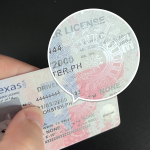In 2025, the fitness industry continues to thrive as more people prioritize their health and well – being. However, one persistent issue that has plagued the industry is the use of fake IDs. Fake IDs can lead to a variety of problems, from underage access to fitness facilities and services to security and liability concerns. This article will explore effective strategies for the fitness industry to safeguard against fake IDs in 2025.
Advanced ID Verification Technology
In 2025, technology has advanced significantly, and fitness facilities should take full advantage of it for ID verification. Biometric verification methods such as fingerprint and facial recognition have become more accurate and cost – effective. For example, when a member enters a fitness center, a facial recognition system can quickly match the person’s face with the image on their registered ID. This not only helps to identify fake IDs but also provides a more seamless and convenient experience for legitimate members. Another emerging technology is iris recognition, which is highly accurate and difficult to forge. Fitness centers can install iris scanners at their entrances or access points to add an extra layer of security.

Additionally, digital ID verification platforms are becoming more prevalent. These platforms use blockchain technology to store and verify identity information securely. Members can upload their government – issued ID documents to a secure digital wallet on their mobile devices. When they visit a fitness facility, the facility can request access to the relevant identity information through the digital ID verification platform. The platform will then verify the authenticity of the ID and provide a verification result to the fitness center, ensuring that only legitimate members gain access.
Employee Training
Well – trained employees are the front – line defense against fake IDs in the fitness industry. In 2025, fitness facilities should invest in comprehensive ID verification training programs for their staff. Employees should be taught how to spot the signs of a fake ID, such as inconsistent font styles, poor – quality printing, or incorrect hologram placement on government – issued IDs. They should also be trained on how to handle situations where they suspect a fake ID. For example, instead of confronting the individual directly, they can discreetly call for a manager or security personnel to handle the situation.

Moreover, employees should be familiar with the different types of valid IDs accepted by the fitness center. In 2025, with the increasing use of digital IDs, employees need to understand how to verify these new forms of identification as well. Regular refresher courses can be organized to keep employees updated on the latest ID – related knowledge and best practices. By having a well – informed and vigilant staff, fitness centers can significantly reduce the risk of fake IDs going undetected.
Database Integration and Sharing
Fitness centers can benefit from integrating their member databases with other reliable identity databases. In 2025, there are likely to be more publicly available and private identity databases that can be used for verification purposes. For instance, fitness centers can partner with credit bureaus or government – run identity verification systems. When a new member signs up, their identity information can be cross – checked against these databases to ensure its authenticity. If there are any discrepancies or red flags, the fitness center can request additional documentation or conduct further verification.

Sharing of information within the fitness industry can also be an effective strategy. Fitness chains or local fitness associations can create a shared database of known fake IDs or individuals with a history of using fake IDs. When a member tries to join a new fitness center within the network, the center can quickly check this shared database to see if there are any issues. This collaborative approach can help to prevent individuals with fake IDs from moving from one fitness facility to another undetected.
Enhanced Physical ID Design and Security Features
Fitness centers can design their own member IDs with enhanced security features in 2025. These IDs can include holograms, microprinting, and watermarks, similar to those found on government – issued IDs. By making their member IDs more difficult to forge, fitness centers can increase the level of security. Additionally, the use of unique barcodes or QR codes on member IDs can be incorporated. These codes can be scanned at access points, and the information can be linked to the member’s profile in the fitness center’s database. This not only helps to verify the ID but also provides real – time access control and monitoring.
Furthermore, fitness centers can consider using RFID (Radio – Frequency Identification) technology in their member IDs. RFID tags can be embedded in the ID cards, and readers can be installed at entrances and key areas of the fitness center. When a member approaches a reader, the system can quickly verify the ID and grant or deny access. RFID technology also allows for tracking the movement of members within the facility, which can be useful for security and management purposes.
Common Problems and Solutions
Problem 1: Technological Glitches
Even with advanced ID verification technology, there may be occasional technological glitches. For example, a facial recognition system may misidentify a legitimate member due to lighting conditions or a change in the member’s appearance (such as growing a beard or wearing new glasses).
Solution: Fitness centers should have a backup verification method in place. This could be a manual ID check where employees visually inspect the member’s ID and cross – reference it with the member’s profile in the database. Additionally, the technology providers should offer regular maintenance and software updates to minimize the occurrence of glitches.
Problem 2: Resistance from Members
Some members may be reluctant to provide biometric data or use new digital ID verification methods due to privacy concerns. They may worry about how their personal data is being stored and used.
Solution: Fitness centers should be transparent about their data – handling practices. They should clearly communicate to members how their biometric or digital identity data will be stored securely, who will have access to it, and for what purposes it will be used. Providing opt – in or opt – out options for certain verification methods (while still ensuring overall security) can also help to ease member concerns.
Problem 3: High Costs of Technology Implementation
Implementing advanced ID verification technologies such as iris scanners or blockchain – based digital ID platforms can be costly for fitness centers, especially small – scale or independent ones.
Solution: Fitness centers can explore cost – sharing options with technology providers or other fitness facilities. For example, a group of small fitness centers in a neighborhood can jointly invest in a digital ID verification platform. Additionally, they can consider phased implementation of technology, starting with more affordable options such as basic biometric fingerprint scanners and gradually upgrading as their budget allows.
Problem 4: Outdated Employee Training
If employee training is not updated regularly, staff may miss new types of fake IDs or be unaware of the latest verification techniques.
Solution: Fitness centers should establish a continuous training program for their employees. This can include monthly or quarterly training sessions on ID verification, as well as providing access to online training resources that employees can use to stay updated on their own time. The training should also cover new trends in fake ID production and detection.
Problem 5: Data Breach Risks
With the increasing use of digital ID verification and data storage, there is a risk of data breaches. If a fitness center’s member database is hacked, members’ identity information could be compromised.
Solution: Fitness centers should invest in robust cybersecurity measures. This includes using firewalls, encryption technologies, and regular data backups. They should also conduct regular security audits to identify and address any vulnerabilities in their systems. In case of a data breach, the fitness center should have a well – defined incident response plan to notify affected members promptly and take steps to mitigate the damage.
Problem 6: Inconsistent ID Standards
There may be differences in what constitutes a valid ID across different regions or types of fitness facilities. This can lead to confusion for members and employees alike.
Solution: The fitness industry, either through national or local associations, should establish clear and consistent ID standards. These standards should be communicated to all fitness facilities and members. Additionally, fitness centers can provide clear guidelines on their websites and at the front desk about what types of IDs are accepted and what the verification process entails.
Problem 7: False Alarms
Advanced ID verification systems may sometimes generate false alarms, flagging legitimate members as potential fake ID users.
Solution: Fitness centers should have a clear process for handling false alarms. This can include a secondary verification step where a manager or senior staff member reviews the situation and makes a final determination. The technology should also be fine – tuned over time to reduce the occurrence of false alarms based on real – world usage data.
Fake ID Pricing
unit price: $109
| Order Quantity | Price Per Card |
|---|---|
| 2-3 | $89 |
| 4-9 | $69 |
| 10+ | $66 |



